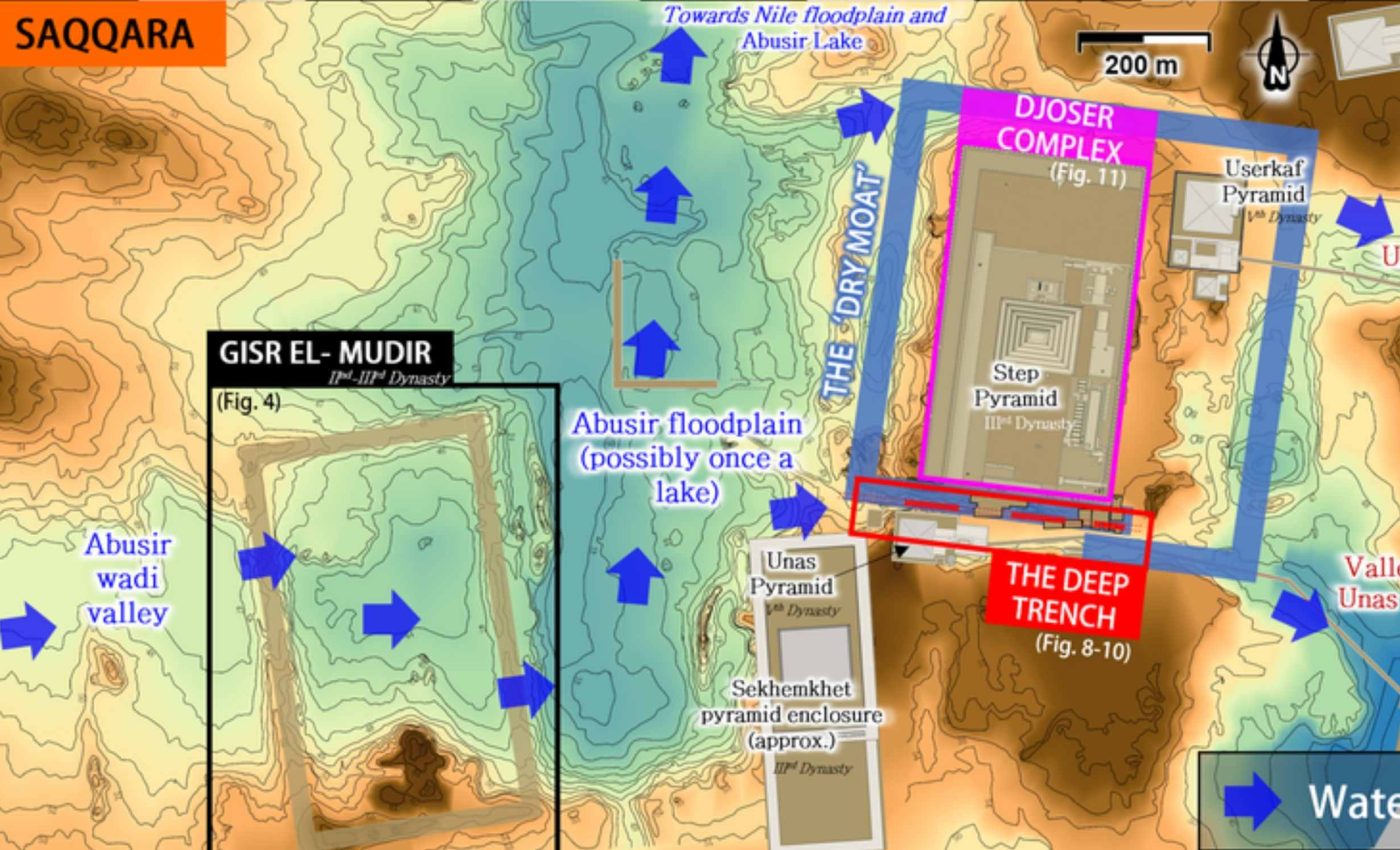
Scientists think the step pyramid was built using water pressure technology 4,500 years ago
The Step Pyramid of Djoser has fascinated explorers for centuries, yet a new angle on its construction has left experts wide-eyed. Researchers examining the ancient site propose that early Egyptian engineers harnessed a powerful system involving water to build what is known as the earliest large stone pyramid in history.
The study points to canal-like structures, a specialized reservoir, and an internal design that may have lifted heavy blocks from the pyramid’s center. According to engineer and lead author Dr. Xavier Landreau from the Sicame Group, these possible water-based methods date back nearly four and a half millennia.
Appreciating an ancient blueprint
The Step Pyramid stands in Saqqara, a desert plateau not far from the Nile’s floodplain. Researchers suggest that a nearby watershed, or land area where water collects and drains, supplied flows that shaped much of the region’s early architecture.
Archaeological surveys uncovered what appears to be a check dam, or a barrier meant to trap sediment and curb flash flooding, on the western side of the site.
This imposing enclosure, known as Gisr el-Mudir, may have once guided storm runoff into more controlled channels.
Shaping water for construction
Clues point to a system that carefully routed water into a stepped series of basins, allowing sediment to settle. Portions of a trench commonly called the Dry Moat contain chambers that might have filtered out debris, leaving cleaner water ready for use.
“Together, the Gisr el-Mudir and the Dry Moat’s inner south section work as a unified hydraulics system that improves water quality and regulates flow for practical purposes and human needs,” wrote Dr. Landreau.
Specialists who mapped the area believe these compartments formed a multi-stage flow arrangement.
Elevating stone blocks
Within the pyramid complex lie two deep shafts that many viewed as grave chambers for King Djoser. On closer look, sealed stone frameworks and a sophisticated layout hint at a hydraulic lift, or water-driven hoisting device, that could have propelled massive blocks upward.
“The ancient architects likely raised the stones from the pyramid center in a volcano fashion using the sediment-free water from the Dry Moat’s south section,” wrote Dr. Landreau.
If correct, workers might have floated giant blocks to higher levels without depending solely on ramps.
Rethinking old kingdom ingenuity
Questions have swirled for decades about how Egyptians set huge stones in place. The possibility of a water-based approach challenges the common idea that simple manpower and ropes were the main tools for stacking these towering monuments.
Some specialists think the pyramid’s watery environment extended beyond just the lift mechanism. Pointers to channels and basins around Saqqara draw parallels with feats at other sites, including the Heit el-Ghurab near Giza.
Fresh inspiration for modern digs
Teams are returning to Saqqara with ground-penetrating radar and updated mapping methods. They aim to pinpoint how a reservoir system might have supplied enough water to power such an elaborate lift, and how long it remained functional in a shifting climate.
Ancient Egyptians already used canals and barges for transportation. The idea that they also handled hydraulic building tactics hints at a level of sophistication that could spark new digs across the plateau and beyond.
Climate and resource realities
Rain patterns in ancient Egypt were not always as sparse as they are today. Some analyses show evidence of heavier precipitation during portions of the Old Kingdom, meaning those channels might have carried more water than modern deserts would allow.
Engineers working on the Saqqara plateau factor in these wetter cycles when calculating how much runoff the pyramid’s reservoir could handle. The combination of flash floods and carefully managed flow could have fueled the entire building effort without straining local communities.
Looking ahead
Some experts are eager to see if similar reservoir systems existed near other pyramids, especially at Meidum or Dahshur.
Corroborating finds would strengthen the idea that hydraulic methods were not just an isolated experiment but a recognized building approach.
Geophysical surveys, drone imaging, and deeper excavations might uncover hidden tunnels or rock-cut basins. Specialists suspect that the step pyramid could be just the start of a new understanding of how ancient construction harnessed water in ways once deemed impossible.
In conclusion
Enthusiasm is growing among scholars who see water infrastructure as a missing piece in the story of pyramid building.
These researchers point out that construction feats may have relied on both manual labor and mechanical innovation, offering two paths for achieving monumental results.
Visitors today walk around a site shaped by a complex interplay of geology, climate, and human creativity. The notion that an ancient civilization could manipulate water so effectively makes the Step Pyramid even more extraordinary.
The study is published in PLoS ONE.
—–
Like what you read? Subscribe to our newsletter for engaging articles, exclusive content, and the latest updates.
Check us out on EarthSnap, a free app brought to you by Eric Ralls and Earth.com.
—–













